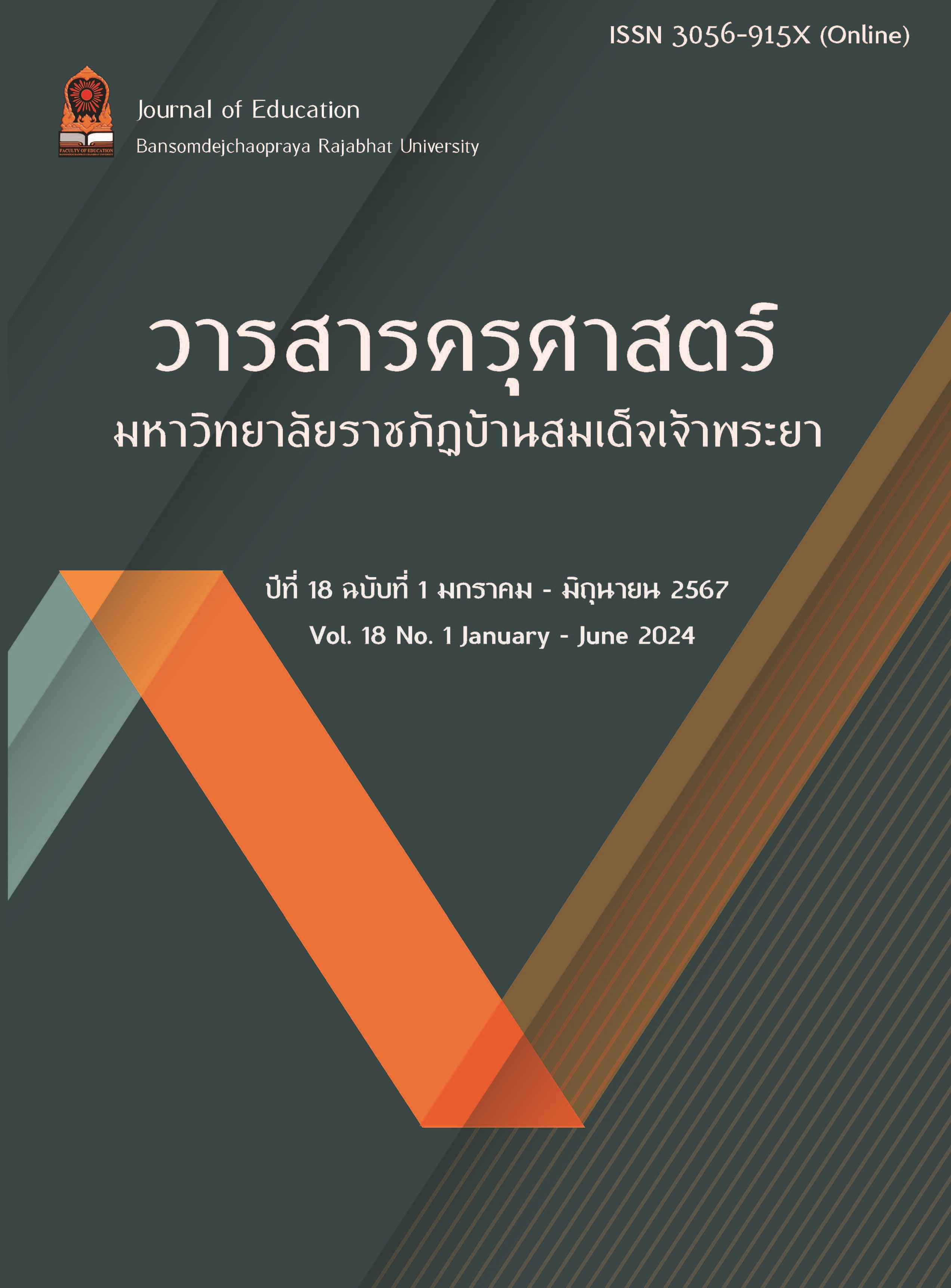Effects of Learning Management by Using Heuristics Problem Solving ApproachAffecting Achievement and Retention in Mathematics Learning on Linear Equation System with Two Variables of Mathayomsuksa 3 Students
Keywords:
learning achievements, linear equation systems with two variables, heuristics problem solving, retention in learningAbstract
The purposes of this research were (1) to compare the mathematics learning achievement on linear equation systems with two variables of mathayomsuksa 3 students before and after studying by using heuristic problem solving (2) to compare the mathematics learning achievement on linear equation systems with two variables of mathayomsuksa 3 students with criterion 60% (3) to study the retention in mathematics learning on linear equation systems with two variables of mathayomsuksa 3 students after studying by using heuristic problem solving and (4) to study satisfaction toward the learning management by using heuristics problem solving on linear equation systems with two variables of mathayomsuksa 3 students. The sample consisted of 33 students who were studying in the mathayomsuksa 3 students of Watsuthiwararam school in the second semester of 2022 academic year. The samples were selected by simple random sampling. The research instruments consisted of (1) 8 the lesson plans using heuristics problem solving on linear equation systems with two variables. (2) the achievement test on linear equation systems with two variables which are 15 items and it is found that the difficulty (p) was from 0.57 to 0.76, the discrimination (r) was from 0.21 to 0.58 and the reliability of test was totally 0.90 and (3) the satisfaction questionnaire toward the mathematics learning by using heuristics problem solving on linear equation systems with two variables which are 15 items. The data was analyzed by mean (), percentage (P), standard deviation (S) and t-test.
The research findings revealed that:
1. The mathematics learning achievements on linear equation systems with two variables after studying by using heuristic problem solving was higher than before, at .05 level of significance.
2. The mathematics learning achievements on linear equation systems with two variables after studying by using heuristic problem solving was higher than the criterion of 60%, at .05 level of significance.
3. The mathayomsuksa 3 students have the retention in learning mathematics on linear equation systems with two variables after studying using heuristic problem solving
4. The satisfaction toward the learning management by using heuristics problem solving on linear systems with two variables of mathayomsuksa 3 students was in the highest level.
Downloads
References
กระทรวงศึกษาธิการ. (2560). ตัวชี้วัดและสาระการเรียนรู้แกนกลาง กลุ่มสาระการเรียนรู้คณิตศาสตร์ (ฉบับปรับปรุง พ.ศ.2560) ตามหลักสูตรแกนกลางการศึกษาขั้นพื้นฐาน พุทธศักราช 2551. กรุงเทพมหานคร: โรงพิมพ์ชุมนุมสหกรณ์การเกษตรแห่งประเทศไทย.
กัญจนาพร บุตรศรีเมือง. (2565). ผลการจัดกิจกรรมการเรียนรู้โดยเน้นการคิดแบบฮิวริสติกส์ร่วมกับการใช้คำถามปลายเปิดที่มีต่อผลสัมฤทธิ์ทางการเรียน และความสามารถในการให้เหตุผลทางคณิตศาสตร์ เรื่อง อัตราส่วนและร้อยละ ของนักเรียนชั้นประถมศึกษาปีที่ 6. (วิทยานิพนธ์ปริญญาวิทยาศาสตรมหาบัณฑิต). มหาสารคาม: มหาวิทยาลัยมหาสารคาม.
เกริกเกียรติ สร้อยบุดดา. (2561). การพัฒนาชุดกิจกรรมการคิดแบบฮิวริสติกส์ร่วมกับเทคนิค STAD ที่มีผลต่อเจตคติทางการเรียนทักษะการแก้โจทย์ปัญหา และผลสัมฤทธิ์ทางการเรียนกลุ่มสาระการเรียนรู้ คณิตศาสตร์ ชั้นประถมศึกษาปีที่ 4. (วิทยานิพนธ์ปริญญาครุศาสตรมหาบัณฑิต). สกลนคร: มหาวิทยาลัยราชภัฏสกลนคร.
ชัยวัฒน์ สุทธิรัตน์. (2558). 80 นวัตกรรมการจัดการเรียนรู้ที่เน้นผู้เรียนเป็นสำคัญ. (พิมพ์ครั้งที่ 7). นนทบุรี: พี บาลานซ์ดีไซด์แอนปริ้นติ้ง.
นูรมา อารี. (2559). ผลการจัดการเรียนรู้แบบ 4 MATที่มีต่อผลสัมฤทธิ์ทางการเรียนความคงทนในการเรียนรู้ และความพึงพอใจต่อการจัดการเรียนรู้ของนักเรียนชั้นมัธยมศึกษาปีที่ 6. (วิทยานิพนธ์ปริญญาศึกษา ศาสตรมหาบัณฑิต). สงขลา: มหาวิทยาลัยสงขลานครินทร์.
รัตน์ติยากร ยตะโคตร. (2561). การจัดการเรียนรู้แบบเน้นการคิดแบบฮิวริสติกส์เพื่อส่งเสริมผลสัมฤทธิ์ทางการเรียน เรื่อง สมการและการแก้สมการ สำหรับนักเรียนชั้นประถมศึกษาปีที่ 6. (วิทยานิพนธ์ปริญญาศึกษาศาสตรมหาบัณฑิต). ปทุมธานี: มหาวิทยาลัยเทคโนโลยีราชมงคลธัญบุรี.
วิโรจน์ เด่นวานิช. (2560). การศึกษาความคงทนในการเรียนรู้ของกระบวนการเรียนรู้แบบร่วมมือ(Collaborative Learning) โดยใช้เทคนิคแผนผังความคิด (Mind Mapping) ของนักศึกษาระดับ ประกาศนียบัตรวิชาชีพชั้นปีที่ 3 สาขางานคอมพิวเตอร์ธุรกิจ. (งานวิจัยในชั้นเรียน). กรุงเทพมหานคร: วิทยาลัยอาชีวศึกษาสันติราษฎร์ในพระอุปถัมภ์ฯ.
สถาบันทดสอบทางการศึกษาแห่งชาติ (สทศ.). (2565). คะแนนเฉลี่ยผลการทดสอบ O-NET ชั้นมัธยมศึกษาปีที่ 6 จำแนกรายสาระและสังกัด. (ออนไลน์). https://catalog.niets.or.th/dataset/it-16-23.[สืบค้นเมื่อวันที่ 4 กุมภาพันธ์ 2566].
สุภารัตน์ กัทลีรัตน์. (2564). ผลการจัดการเรียนรู้ด้วยกระบวนการ BBL (Brain Based Learning) ร่วมกับแนวคิดแบบฮิวริสติกส์ (Heuristics) ในการพัฒนาทักษะ กระบวนการแก้โจทย์ปัญหาทางคณิตศาสตร์ เรื่อง ร้อยละ ของนักเรียนระดับประกาศนียบัตรวิชาชีพ วิทยาลัยอาชีวศึกษาพิษณุโลก. (วิทยานิพนธ์ปริญญาครุศาสตรมหาบัณฑิต). อุตรดิตถ์: มหาวิทยาลัยราชภัฏอุตรดิตถ์.
อรีนา ปัดตาล. (2562). การพัฒนาทักษะการแก้ปัญหาคณิตศาสตร์ เรื่อง การเรียงสับเปลี่ยน ที่เน้นการคิดแบบฮิวริสติกส์ร่วมกับเทคนิคเพื่อนคู่คิด ของนักเรียนชั้นมัธยมศึกษาปีที่ 6. (วิทยานิพนธ์ปริญญาวิทยาศาสตรมหาบัณฑิต). กรุงเทพมหานคร: มหาวิทยาลัยศิลปากร.
Downloads
Published
How to Cite
Issue
Section
License
Copyright (c) 2024 Faculty of Educaion Bansomdejchaopraya Rajabhat University

This work is licensed under a Creative Commons Attribution-NonCommercial-NoDerivatives 4.0 International License.
บทความที่ได้รับการตีพิมพ์เป็นลิขสิทธิ์ของคณะครุศาสตร์ มหาวิทยาลัยราชภัฏบ้านสมเด็จเจ้าพระยา
ข้อความที่ปรากฏในบทความแต่ละเรื่องในวารสารวิชาการเล่มนี้เป็นความคิดเห็นส่วนตัวของผู้เขียนแต่ละท่านไม่เกี่ยวข้องกับมหาวิทยาลัยราชภัฏบ้านสมเด็จเจ้าพระยา และคณาจารย์ท่านอื่นๆในมหาวิทยาลัยฯ แต่อย่างใด ความรับผิดชอบองค์ประกอบทั้งหมดของบทความแต่ละเรื่องเป็นของผู้เขียนแต่ละท่าน หากมีความผิดพลาดใดๆ ผู้เขียนแต่ละท่านจะรับผิดชอบบทความของตนเอง



